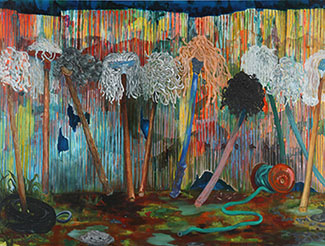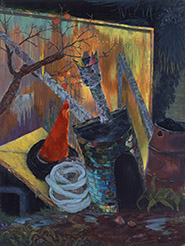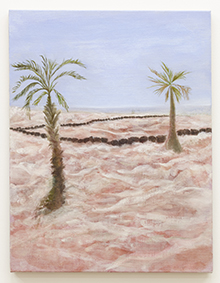|
Installation view from Daisuke Fukunaga: Documenting Senses - From Cats' Eyes, not Dogs' at Tomio Koyama Gallery, 2015. Left: Blooming at a Factory (2015), oil on canvas, 182.5 x 259.0 cm. Right: Flexible Containers Bag (2015), oil on canvas, 97.0 x 162.0 cm.
© Daisuke Fukunaga; photo by Kenji Takahashi |
Old mops, old tires, discarded electric fans, bits of plastic street detritus, all quivering with life like tropical underwater plants and painted with a lush, psychedelic palette . . . At first glance these appear to be gritty urban snapshots channeled through Salvador Dali. But Daisuke Fukunaga is no surrealist. His subjects are real and inanimate, but he skillfully and enthusiastically imbues -- or maybe a better word is "infects" -- them with life. The results are vivid, colorful, and vaguely unsettling, like a still life of fruit that is beginning to rot.
Fukunaga is partial to certain motifs -- notably mops, which feature prominently in several of the new oil paintings in his current solo show (at the Tomio Koyama Gallery in Sendagaya, Tokyo until October 17). But these are no ordinary mops: with their squiggly, multihued tendrils they resemble sea anemones or jellyfish, pretty but poisonous. In the past Fukunaga has sometimes gotten a little carried away with the anthropomorphic aspect of these cleaning tools, giving them faces and titles like Married Mops (2006) or Have a Break! (2007) -- in which several mops lounge against a corrugated-iron fence like a gang of day laborers having a smoke. The whimsy is merely cute, and if anything detracts from the otherwise superb composition and coloring of the works.
 |
|
|
|
Left: Sky (2015), oil on canvas, 194.5 x 97.0 cm. Right: Planter (2015), oil on canvas, 194.5 x 97.0 cm.
© Daisuke Fukunaga
|
 |
|
 |
|
|
|
Have a Break! (2007), oil on canvas, 194.0 x 259.0 cm.
© Daisuke Fukunaga |
|
Local Emotion (2007-08), oil on canvas, 259.0 x 194.0 cm.
© Daisuke Fukunaga |
Titling this show Documenting Senses - From Cats' Eyes, not Dogs', Fukunaga describes his attraction to such objects as follows: "Sometimes I see mops on street corners, abandoned tires on roads, wheels displayed in show windows, and motorbike seats highlighted under street lights as indescribable sculptures . . . I capture my astonishment . . . and document the emotions I find there . . . with the eyes of a stray cat wandering aimlessly and staring into something."
An innocent, joyful astonishment does indeed shine through Fukunaga's works. And yet -- though the distinction he makes between a cat's and a dog's viewpoint escapes me -- there is definitely a certain coolness with which he approaches his subjects. The wild and wavy hyper-representation notwithstanding, he is painting things as they are. In Local Emotion (2007-08), for example, random objects -- a traffic cone, a coil of rubber tubing, an oil drum, a small brick incinerator -- glow in garish light reflecting off the back of the billboard they have been tossed behind. Fukunaga explains that he painted the scene just as he found it. Perhaps there is indeed something more feline than canine about this impartiality.
Sculpture on a Street (2015), oil on canvas, 162.0 x 194.0 cm.
© Daisuke Fukunaga
|
Art critic Noi Sawaragi, quoted on the gallery's website, associates the "things as they are" quality of Fukunaga's work with the Mono-ha (literally "school of things") movement of the 1970s: "The mop is simply there . . . it reveals the ground of being that underlies the mop as an existing entity." Uh, okay. Actually, the critic may have a point. Fukunaga's work is most successful when he reins in his impulse to embellish, and his objects are "simply there." One of the loveliest of his still lifes is an assemblage of mops and brooms sticking out of a trashcan amid some odds and ends of debris. Painted in their natural shades of dirty gray against a two-tone blue background (the title is a simple and appropriate Sky), the tools look almost like dried flowers, or dandelion tufts. The effect is subdued yet stunning: beauty found not merely in the mundane, but in the discarded and disregarded.
Born in Tokyo in 1981, Fukunaga had his first solo show at Tomio Koyama Gallery in 2006, not long after graduating from Tama Art University. Since then he has appeared at Koyama venues in Tokyo or Kyoto every couple of years. This latest exhibition also affords an opportunity to check out the gallery's recently opened Sendagaya digs.
Early Summer (2015), oil on canvas, 27.3 x 22.0 cm.
© Daisuke Fukunaga
|
Until this past spring, the main Koyama gallery occupied the entire top floor of the Maruhachi Warehouse in Kiyosumi, on the east side of the Sumida River. The industrial ambience of the neighborhood, the building, and the space itself seemed just right for showcasing the Koyama's vaunted roster of big-time contemporary artists, both domestic and foreign. There was also an element of esprit de corps at the Maruhachi site, which the Koyama shared with several other galleries. All had converged there after a period of nomadic wandering along the Sumida from one converted warehouse to another, as each was demolished in turn to make way for condominiums.
Alas, even the Maruhachi proved vulnerable to Tokyo's frenetic real-estate market. According to gallery founder Tomio Koyama, last year the owner of the warehouse suddenly decided to tear it down and replace it with condos. The result was a diaspora of the Maruhachi art community to points scattered across Tokyo. Koyama decided to relocate to the west side of the Yamanote loop line, in a more sedate (and more expensive) neighborhood -- Sendagaya, conveniently situated midway between the busy shopping and nightlife districts of Shinjuku and Harajuku.
The Back Side (2015), oil on canvas, 24.2 x 41.0 cm.
© Daisuke Fukunaga
|
Sharing a renovated building with Taka Ishii Gallery, another former Maruhachi tenant, the Koyama now makes do with a far more intimate space, which it opened in June with a show of work by the late American outsider artist James Castle. But the Sendagaya venue is complemented by a second, also relatively new site in bustling Shibuya, just a couple of subway stops away -- 8/ Art Gallery, which opened in 2012 on the eighth floor of the Hikarie highrise shopping complex. In a video interview, Koyama says, "This gallery in Sendagaya is focused on what you might call the 'international art scene,' while for my Shibuya gallery, I want to focus on an approach that takes into consideration the domestic Japanese market." He adds, "I want to support both established and emerging artists, as well as those who work in other genres, such as design and craft. But at Sendagaya I'd like to focus on work that is closer to what you might call 'art.'"
|
 |
|
|
|
On the Beach 2 (2015), oil on canvas, 53.0 x 41.0 cm.
© Daisuke Fukunaga
|
In fact, the more sedate, less industrial vibe of the Sendagaya space is just right for introducing artists like Fukunaga who work in two-dimensional, non-monumental formats. Here, paintings do not get dwarfed by cavernous, high-ceilinged rooms like those at the Maruhachi, nor do they have to compete with the distracting buzz from adjacent shops as at Hikarie. If the Koyama Gallery is serious about continuing to exhibit promising but lesser-known artists in addition to its big-name clients, Sendagaya is the perfect place.
All works shown are by Daisuke Fukunaga; all images are courtesy of Tomio Koyama Gallery.
|
 |
|
| |
3-10-11 Sendagaya, Shibuya-ku, Tokyo
Phone: 03-6434-7225
Hours: 11 a.m. - 7:00 p.m., Tuesday - Saturday
Closed Sunday, Monday, and national holidays
Access: 2 minutes' walk from Kitasando Station on the Tokyo Metro Fukutoshin Line |
|
|
| |
 |
Alan Gleason
Alan Gleason is a translator, editor and writer based in Tokyo, where he has lived for 30 years. In addition to writing about the Japanese art scene he has edited and translated works on Japanese theater (from kabuki to the avant-garde) and music (both traditional and contemporary). |
|
|
|
|